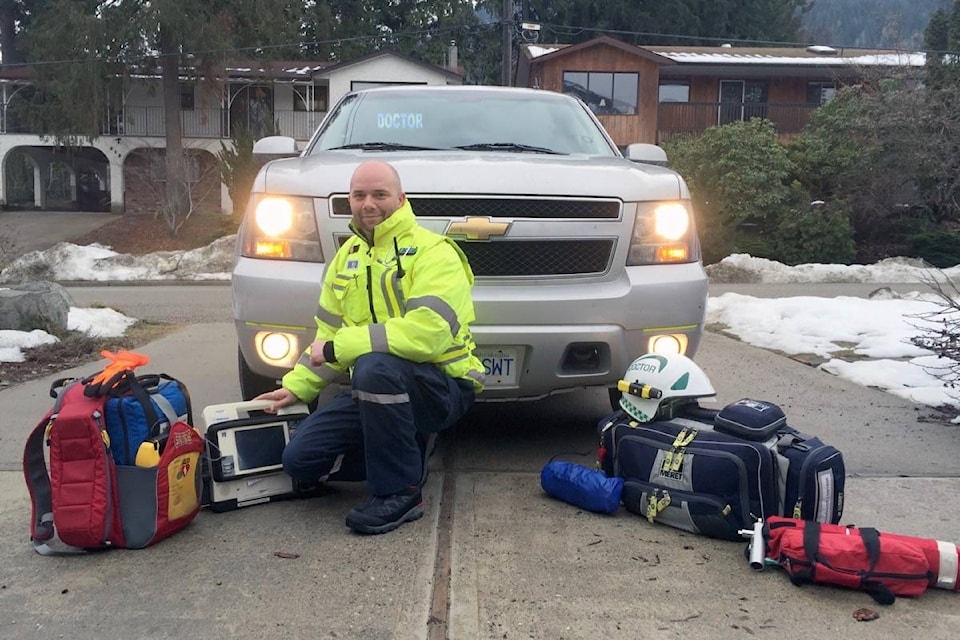For most people, going above and beyond means working overtime to complete an important project or help a neighbour out of a tough situation.
But for Dr. Nic Sparrow, going above and beyond means saving people’s lives or drastically changing the recovery outcome of a severe injury or health crisis, and he is hoping more doctors and community members will join in the fight.
Sparrow is an emergency room doctor at Kootenay Lake Hospital in Nelson, but he feels the duty of saving lives doesn’t end when he leaves the hospital at the end of his shift.
Sparrow remains on call and often leaves the comforts of his home for some of the harshest realities of life — the most severe 9-1-1 calls in the West Kootenay. He does this work as a volunteer — giving his time and providing his own supplies and equipment.
The idea of doctors attending accident scenes, cardiac arrest calls and drug overdoses seems like a new approach here in Canada, but the practice is actually quite common in Europe and other parts of the world.
Sparrow first became familiar with the practice while working in the United Kingdom.
After moving to Canada, Sparrow started volunteering his time for this type of work in 2008 while working on the Sunshine Coast.
Sparrow is quick to emphasize that he does not do this work alone, that it is a team effort — he is there to support the first responders, ambulance attendants, paramedics and fire department personnel.
“I think they do an absolutely amazing job — but there are some calls that a physician who is trained in pre-hospital response can assist with,” said Sparrow.
“To support the emergency services, and secondly to help save lives and help the most critically ill or injured patients in the community — that is my goal,” explained Sparrow who has attended 260 calls over the last four years.
Sparrow says its hard to calculate how many lives have been saved through the work.
“I’m not working in isolation, I’m working always with the paramedics, with the firefighters — so it is hard to equate to lives saved. But I have definitely, massively changed the outcome for a subset of critically ill patients,” he said.
This is partly because he is able to provide things like anti-seizure medications — stopping patients from enduring long periods of seizures and advanced life support drugs and treatments to the scene of cardiac arrests.
“There are certain things that I can provide that other providers at the moment in the pre-hospital environment cannot — that’s partly why I respond,” said Sparrow.
“The paramedics on the ground and the firefighters … they have to deal with some really tough stuff and work in the confines of what they are allowed to do — when we have basic life support, there are only a limited number of things the province allows them to do.”
Before moving to Canada, Sparrow responded with the ambulance service of the UK as a first responder and also alongside ambulance services in South Africa.
“I have seen the benefit of having physicians in rural areas respond,” he said.
“I think it should be a national program. There should be volunteer pre-hospital trained physicians — and maybe in the fullness of time it won’t be volunteer — across the province in rural areas assisting the ambulance service.”
Kootenay Emergency Response Physicians Association
Sparrow and others have formed a non-profit organization to help fund this work — the Kootenay Emergency Response Physicians Association (KERPA).
He hopes other physicians will join him in the work but explained it may take a while before that could happen.
“There is quite a lot of specialist training you require to translate your emergency skills into the pre-hospital setting,” explained Sparrow.
He also knows the idea is a tough sell.
“It’s an unusual model because you are not being paid for your time, you are on call 24/7 unless you turn your phone off. It’s not an overly attractive job concept.
“You have to be slightly weird in order to want to do it — hopefully the Kootenays will attract some more weird people to join me,” added Sparrow.
KERPA has developed a wish list that includes a designated marked vehicle to take to the scene of calls. The vehicle could then be stocked with the necessary equipment and outfitted with lights and sirens.
Sparrow has been using a LifePak 12 defibrillator/monitor on loan from Interior Health and an upgrade to a LifePak 15 is also on the organization’s list.
They would also like an automated chest compression device — the LUCAS 3.
KERPA has already raised about $20,000 and has purchased a state-of-the-art hand-held ultrasound machine.
The above equipment will cost about $75,000 to $100,000 so KERPA is looking for a dealership or someone else to sponsor the vehicle and is accepting donations through its Facebook page.
“We are just a volunteer organization, trying to help — we have no political agenda,” added Sparrow. “I feel I have a duty to help these people and I am going to do it — I’m just going to do it.”
And that is where the conversation ended — Sparrow’s phone rang, and he was needed elsewhere.




